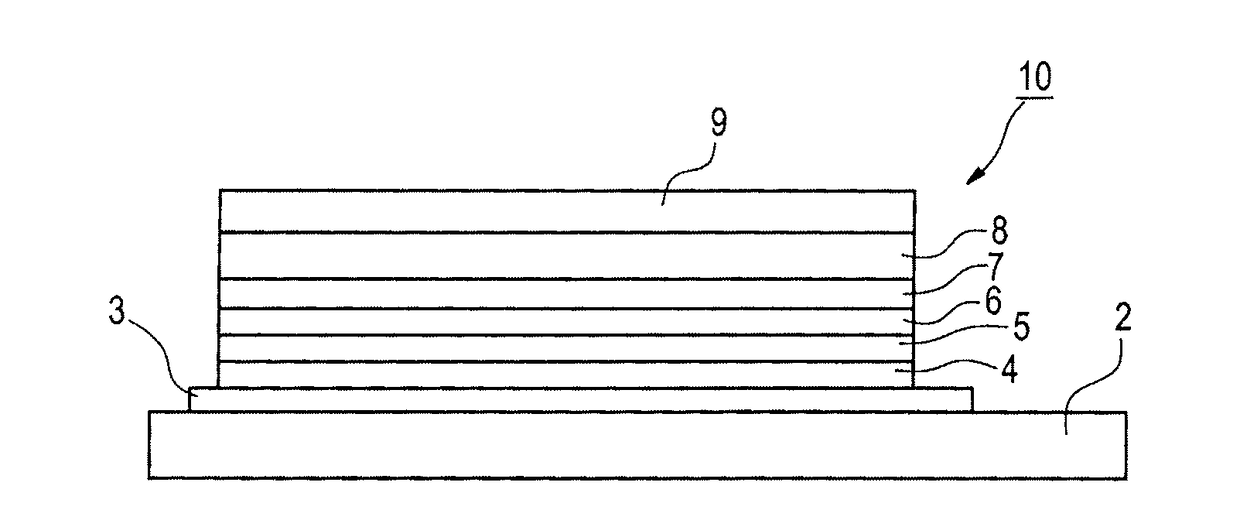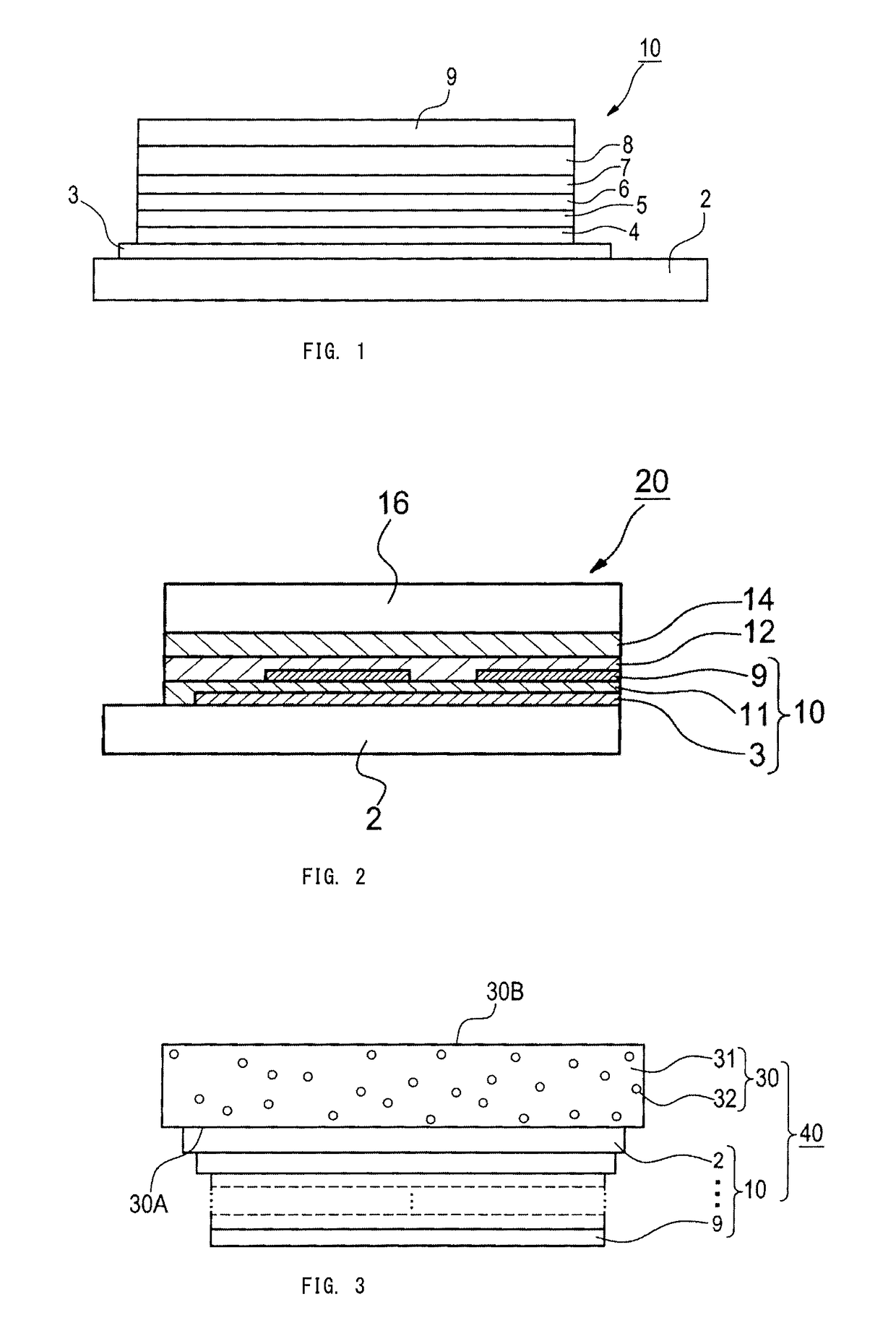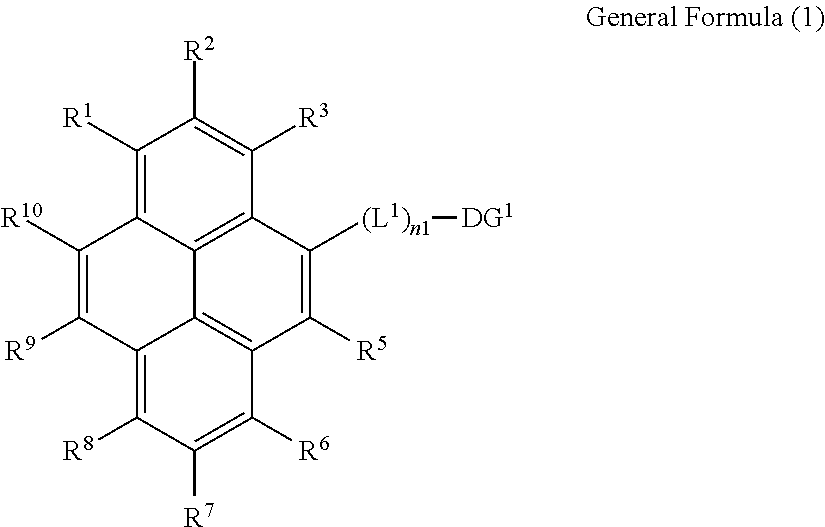Organic Electroluminescent Element, Compound for Use in the Element, and Light Emitting Device, Display Device, and Illumination Device Using the Element
a technology of electroluminescent elements and compounds, applied in the field of organic electroluminescent elements, can solve the problems of poor chromaticity and insufficient performance (including luminous efficiency) of light emitting materials, and achieve excellent chromaticity, sufficient luminous efficiency, and sufficient luminous efficiency.
- Summary
- Abstract
- Description
- Claims
- Application Information
AI Technical Summary
Benefits of technology
Problems solved by technology
Method used
Image
Examples
example 1
1. Synthesis of Compounds Represented by General Formula (1)
[0323]The compounds represented by the general formula (1) can be synthesized by a combination of known reactions, including the methods descried in JP-A-2009-283899, and JP-A-2006-298793. The following describes representative examples of specific synthesis procedures for the compounds represented by the general formula (1).
Synthesis of Compound 1
[0324]
Synthesis of Compound 1a
[0325]Bromine (26 ml) was dropped onto a dichloromethane solution (500 ml) of 1,2,3,6,7,8-hexahydropyrene (ALDRICH; 50 g) at room temperature, and the mixture was stirred for 4 hours. The precipitated crystals were filtered, and washed with ethanol and hexane to obtain compound 1a (39 g).
Synthesis of Compound 1b
[0326][1,1′-bis(Diphenylphosphino)ferrocene]palladium(II)dichloride (PdCl2(dppf); 0.8 g) was added to a toluene solution (60 ml) of compound 1a (5 g), bispinacoldiborane (17.4 g), and potassium acetate (4 g), and the mixture was stirred under n...
example 2
Production and Evaluation of Organic Electroluminescent Element
[0332]The materials used for the production of the organic electroluminescent element were all purified by sublimation, and the purity (absorption intensity area ratio at 254 nm) was confirmed to be 99.9% or higher by high-performance liquid chromatography (Tosoh TSK gel ODS-100Z).
[0333]A 0.5 mm-thick and 2.5 cm square glass substrate (product of Geomatec Co., Ltd., surface resistance: 10 Ω / quadrature) having an ITO film thereon was put in a cleaning container. After ultrasonic cleaning in 2-propanol, the glass substrate was subjected to a UV-ozone treatment for 30 minutes. The following organic compound layers were deposited sequentially on the transparent anode (ITO film) by a vacuum deposition method.
[0334]Note that the deposition rate in the Examples and Comparative Examples below is 0.1 nm / sec unless otherwise specifically indicated. The deposition rate was measured using a quartz oscillator. In addition, the thickn...
example 3
[0345]Organic electroluminescent elements 2-1 to 2-11 and comparative elements 2-1 to 2-4 were produced in the same manner as in Example 2, except that the layer configurations were changed as follows. Evaluations were carried out in the same manner as in Example 2. The results are presented in Table 3 below. Note that the external quantum efficiency shown in Table 3 below is shown as a relative value, taking the value of the comparative element 2-1 (organic electroluminescent element using comparative compound 1) as 1.0.
First layer: HT-4: thickness 50 nm
Second layer: HT-3: thickness 45 nm
Third layer: H-2 and light emitting material (mass ratio=95:5) shown in Table 3: thickness 25 nm
Fourth layer: ET-5: thickness 5 nm
Fifth layer: ET-3: thickness 20 nm
TABLE 3RelativeChromaticityLightexternalafteremittingquantumdeteriorationElement No.materialefficiencyChromaticityby drivingNoteElement 2-1Compound 11.1GoodGoodPresentInventionElement 2-2Compound 31.2GoodGoodPresentInventionElement 2-3Co...
PUM
| Property | Measurement | Unit |
|---|---|---|
| luminous wavelength | aaaaa | aaaaa |
| luminous wavelength | aaaaa | aaaaa |
| luminous wavelength | aaaaa | aaaaa |
Abstract
Description
Claims
Application Information
 Login to View More
Login to View More - R&D
- Intellectual Property
- Life Sciences
- Materials
- Tech Scout
- Unparalleled Data Quality
- Higher Quality Content
- 60% Fewer Hallucinations
Browse by: Latest US Patents, China's latest patents, Technical Efficacy Thesaurus, Application Domain, Technology Topic, Popular Technical Reports.
© 2025 PatSnap. All rights reserved.Legal|Privacy policy|Modern Slavery Act Transparency Statement|Sitemap|About US| Contact US: help@patsnap.com



